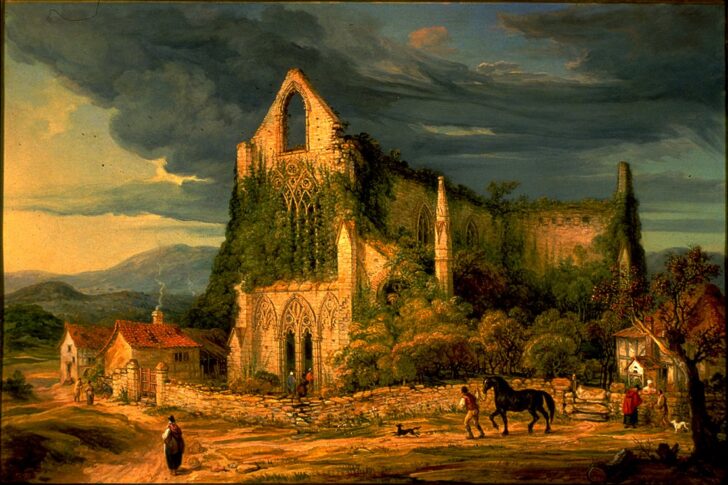Tintern Abbey
James Ward

Description
March 28, 2009
Tintern Abbey, a twelfth-century Cistercian monastery located in Gwent, South Wales, served as a source of inspiration for numerous artists and writers in the early nineteenth century. They found in it a paradigm for feelings of loss, of yearning for a heroic past now increasingly threatened in the face of modern Britain’s rising industrialism. The Abbey was most famously immortalized by the English Romantic poet William Wordsworth in “Lines, Composed a Few Miles Above Tintern Abbey, on Revisiting the Banks of the Wye During a Tour, July 13, 1798.”
Ward’s Tintern Abbey is overrun with verdant foliage, surrounded by the everyday life of shoeless wayfarers, laborers, chattering townsfolk, beggars, and farmyard animals. The Abbey became the centerpiece of the most frequently made British tour during the 1790s (the Wye River valley, the historical border between England and Wales), in an age when modern tourism was still relatively new. Thousands of travelers, guidebook in hand, visited and revisited the picturesque ruins and responded with feeling to the beauties and sublimities of the surrounding nature. The rising sensitivity to nature and one’s physical surroundings to which both Wordsworth and Ward were subject was itself at least partly due to the rise of interest in landscape painting, so that Ward’s landscape merges an interest in painterly craft with a longing for the imagined paradise of the pre-industrial age in which God, man, and nature coexisted in harmony.
Subject Matter:
Ward's depiction of the famous ruined abbey in south Wales on the Wye river portrays the church in a golden light that evokes a bygone age. This lush Romantic landscape with its picturesque ruin and dramatic, stormy sky evokes an image of rural England that was quickly passing in this era of the Industrial Revolution. The gothic ruin was described by William Wordsworth in one of his most famous poems and similarly uses the abbey to recall memories of the past.
Physical Description:
A large, Gothic ruin dominates the scene. The west portal of a large church stands with full light, from the left, illuminating its portal. Along its second story ivy grows across the facade while trees cluster in the L-shaped angle toward the right and other vegetation is evident along the roofline of the structure. Several women enter through the main doorway of the building. A stone wall encircles the structure and two houses occupy the land immediately to the left of the church ruin. In the foreground a lane leads past the church with a man leading a black horse and a running hound in the right foreground, and a figure with its back to the viewer is visible at the left foreground. Behind the scene, dark, wind-swept clouds indicate a recent storm that has now passed, allowing golden light to suffuse the landscape.
Usage Rights:
If you are interested in using an image for a publication, please visit https://umma.umich.edu/request-image/ for more information and to fill out the online Image Rights and Reproductions Request Form.